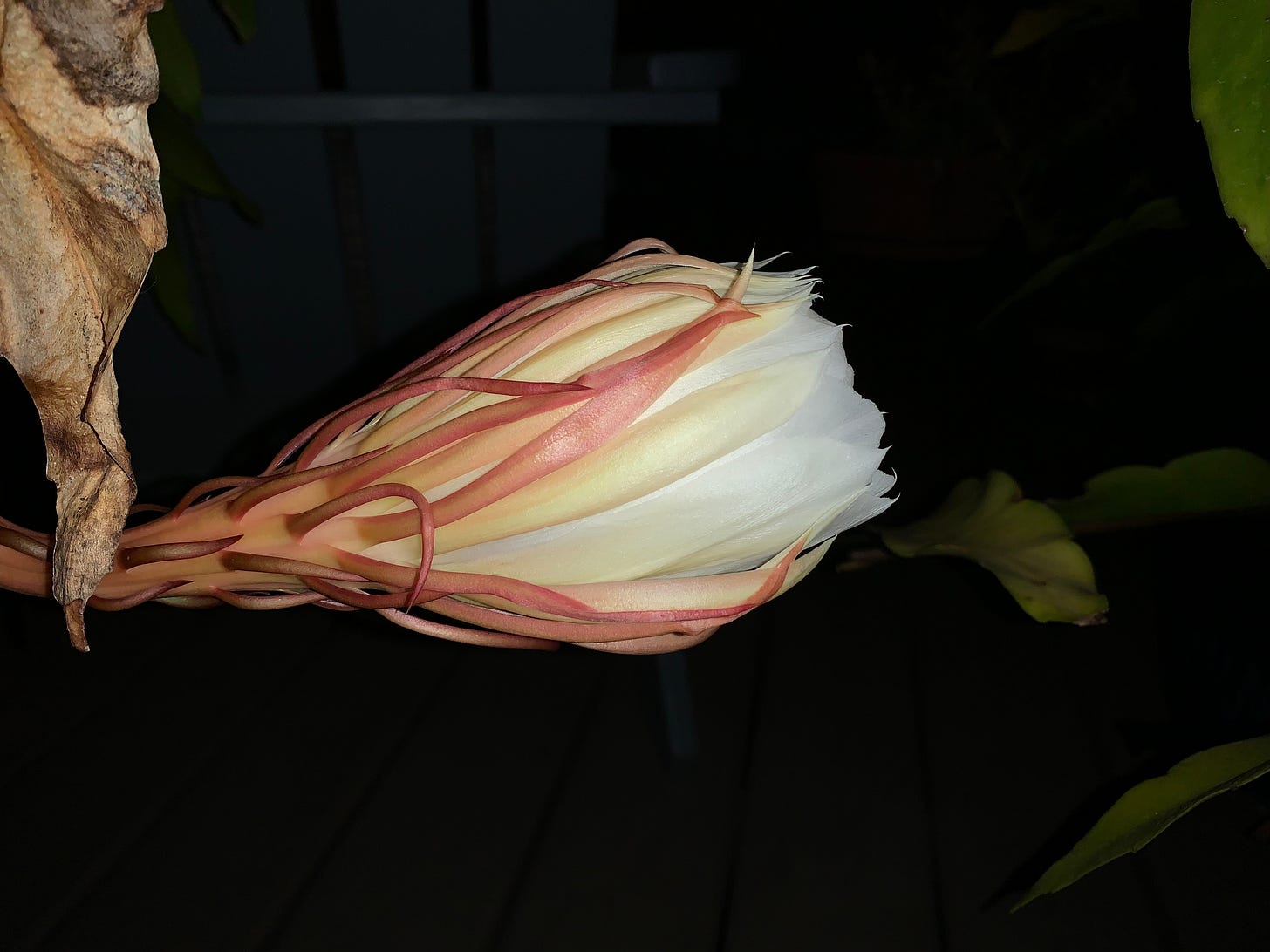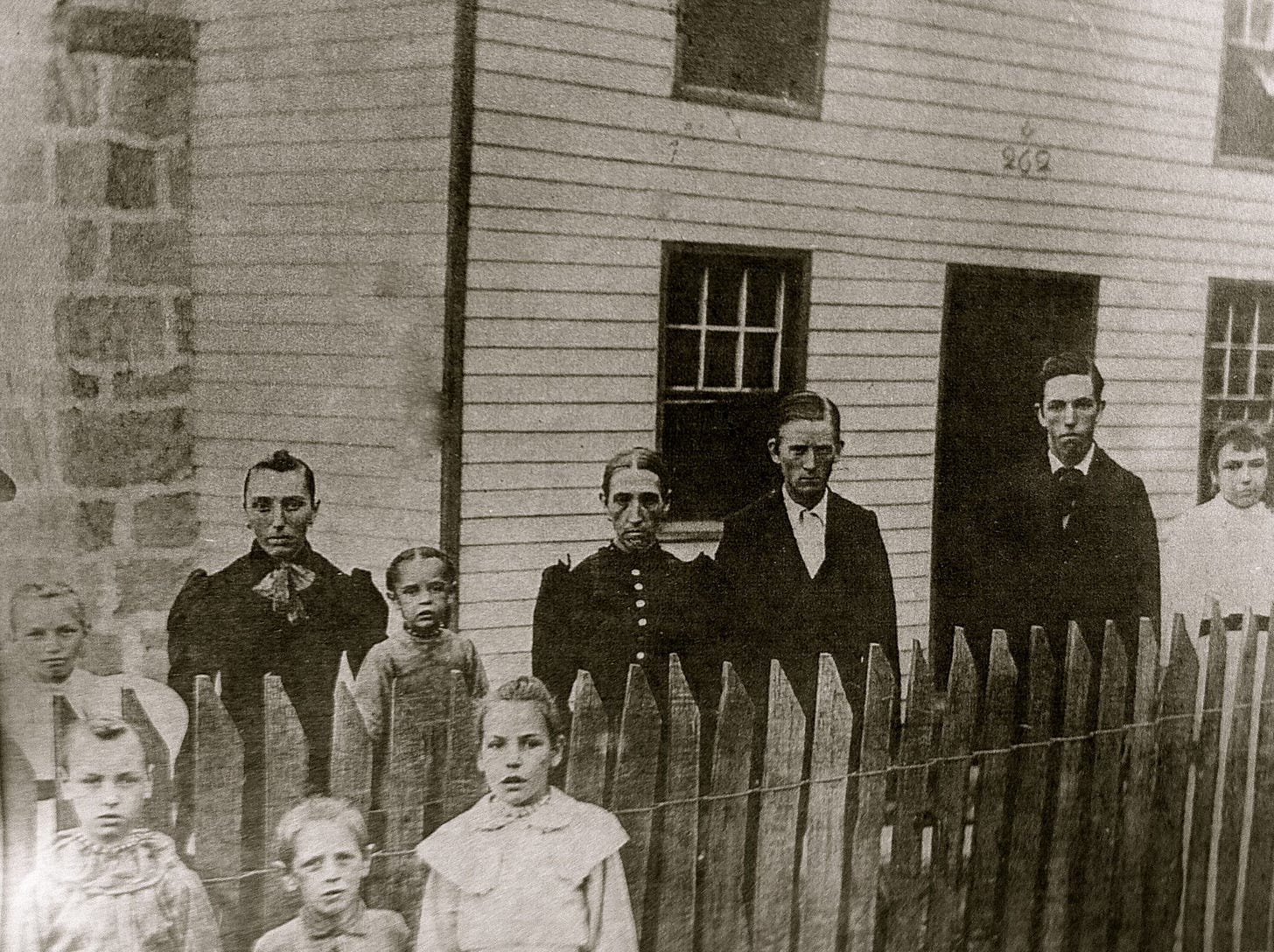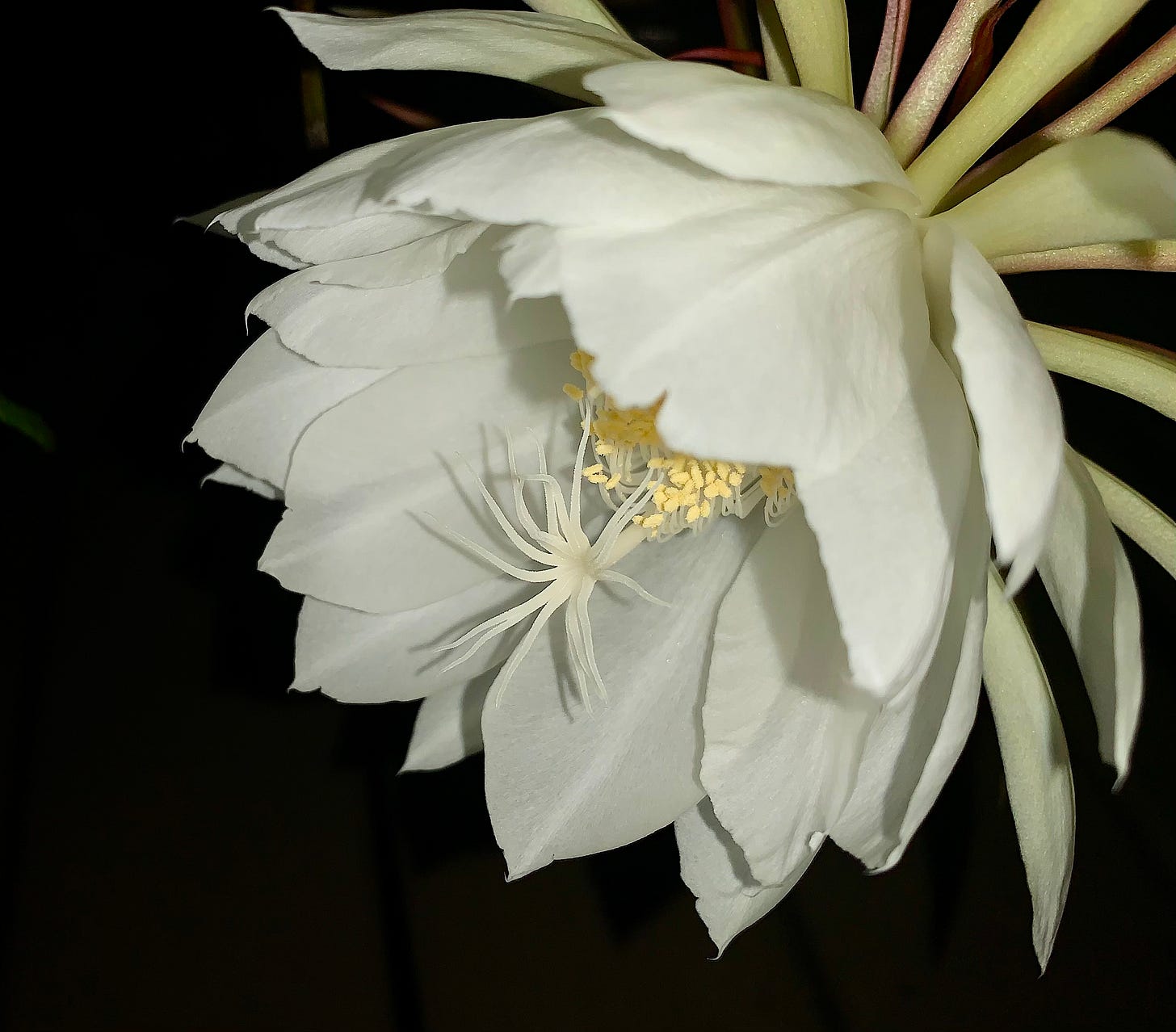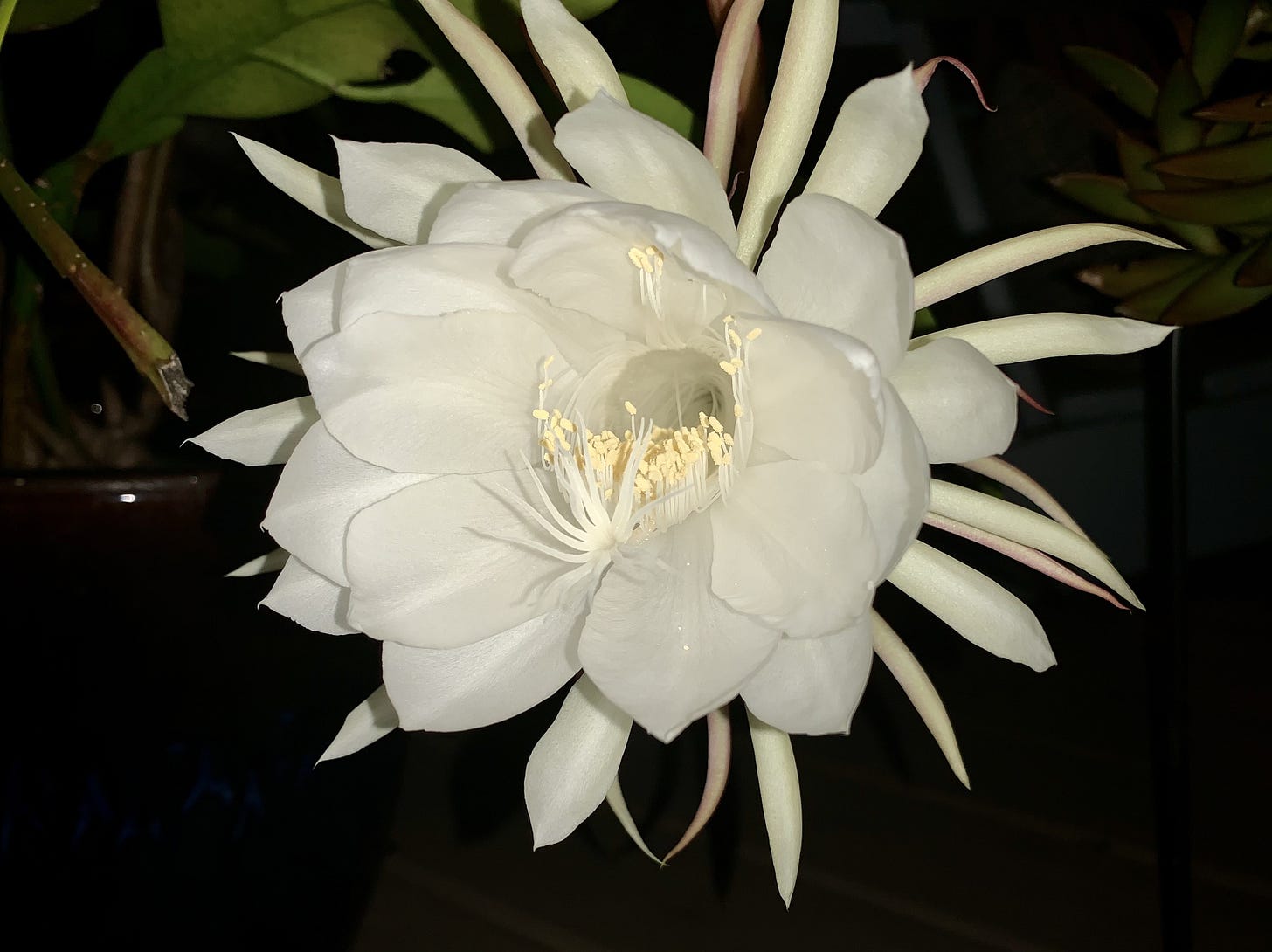Night Bloom
Six generations. One flower. One night.
Tonight, a plant far older than I am will open.
She waits all year for this. No schedule. No fanfare. Just one long exhale after sundown, one bloom under cover of night — and by morning, she’s gone. Not dead. Not dying. Just… done. Finished with her brief act of theater. Back to waiting again.
The plant is Epiphyllum oxypetalum, commonly called the Queen of the Night1 — a tropical cactus native to Central America2, where she clings to trees in the rainforest canopy and drinks from the humidity in the air. She blooms only once a year, always at night, always briefly. In some cultures, she’s considered sacred3. In others, a sign of unexpected fortune or a visitation from the divine. In my family, she’s an heirloom — passed down for six generations through the hands of women who understood how to wait.
She came down to us like other heirlooms never could — not locked in a drawer, but living. We didn’t talk about her much. We simply kept her alive. And in doing so, kept something else alive too.
She lives mostly in my sunroom now, soaking up the morning light through the glass. In summer, I carry her out onto the deck — she loves the humidity. But when the days shorten and the shadows change, I start watching. And waiting. She’s never bloomed at the same time twice.
Tonight, the Queen is preparing to bloom. And as fate would have it, it’s also my sister’s fifty-fifth birthday — a woman who has spent her entire life teaching others, raising three remarkable children of her own. She’s an award-winning teacher, recognized as a role model and a positive influence in her community.

And though my sister has never been her keeper, the Queen belongs to her story too — because the women in our family have always been bound together by the things they’ve tended, whether gardens or children or history. And tonight, her bloom ties us both to the same long thread, a line running through the hands of women in our family all the way back to where her story began.
Where It Began
We trace the Queen’s story — at least what we know — to my third great-grandmother, Mariah Catherine Lucas4, born in the mid-nineteenth century in Breckinridge County, Kentucky. She married Samuel Thomas Whitworth Jr. in 1866, had ten children, and divorced him in 1903 — a bold decision for a woman of her time5.

Mariah lived for a while near a place called Falls of Rough6, a community that straddled Breckinridge and Grayson counties. At the turn of the twentieth century, Falls of Rough was more than a dot on the map. It was a hub — a working mill town with a resort hotel, general store, and trading post, all fueled by the Green River, which ran into the Ohio not far downstream. Paddleboats once glided past the limestone banks. Cargo arrived from cities upriver and down. The same hills that sheltered mill workers and hotel guests also hid moonshine stills in their folds — valleys where secrets lingered longer than sunlight.
It’s easy to imagine how a rare plant — a tropical cactus — might have found her way into a garden there. Perhaps brought by a doctor’s wife, a hotel guest, or a traveling merchant. Perhaps tucked into a trunk wrapped in damp cloth, a curiosity picked up from New Orleans or Havana. Perhaps a gift.
Mariah gave her a place to grow. And when she bloomed — as she sometimes did — she opened her gate to the hush of lanterns and footsteps, the air thick with anticipation.
Midnight in Breckinridge County
Family lore says Mariah hosted midnight garden parties when the Queen was preparing to flower. Word traveled through the hills. Neighbors walked or rode in under moonlight, gathering around her with kerosene lanterns, coffee mugs in hand — some with a little something extra to take the edge off — and apple hand pies still warm from the hearth. Someone always brought a second pie, and someone else always brought the good stuff. There were no speeches. No piano music. Just candlelight and waiting. And at least one neighbor, according to legend, came mostly for the bourbon and the bloom. When the flower finally opened — often after midnight — there were gasps, tears, silence.
These gatherings weren’t unique to Kentucky.
In the 1930s and ’40s, newspapers from Houston to Indianapolis reported on Queen of the Night bloom parties across the country7. In New Orleans, they served cocktails and recited poetry under strings of Chinese lanterns8. In Houston, neighbors came in formal dress, standing barefoot on porches at midnight, watching the bloom unfurl as if it were a sacred rite9. In Indianapolis, one woman took a photograph of her plant at full bloom and mailed it to her children in California: “She won’t bloom again this year,” she wrote, “but I wanted them to see her anyway”10.
In Jackson, Mississippi, author Eudora Welty and her friends formed an unofficial Night-Blooming Cereus Club, gathering each summer to watch a single blossom open under the stars11. They described the flower’s movement like something alive — trembling, shuddering, then unfurling her slender white petals like a chalice. Welty once called her “a delicately incised saucer full of froth”12. By morning, she said, the bloom hung like “a wrung chicken’s neck.” And still, they came — every year.
In Georgia, a gardener remembered her grandmother’s summer bloom ritual:
“Once a year on a midsummer night that could not be foretold, a curious plant would decide to undrape its petals… Neighbors would arrive around midnight. They rocked in the porch swing and waited. They inhaled its sugary scent and tried to find the baby Jesus in the cradle in the folds.”13.
In some towns, someone always read a poem. Often it was something fleeting and lovely — a few lines to match the mood of the flower. One such poem, published in 1917, would have felt just right spoken aloud beneath lantern light:
Barter
by Sara Teasdale (from Love Songs, 1917)
Life has loveliness to sell,
All beautiful and splendid things,
Blue waves whitened on a cliff,
Soaring fire that sways and sings,
And children’s faces looking up
Holding wonder like a cup.Life has loveliness to sell,
Music like a curve of gold,
Scent of pine trees in the rain,
Eyes that love you, arms that hold,
And, for your spirit’s still delight,
Holy thoughts that star the night.Spend all you have for loveliness,
Buy it and never count the cost;
For one white singing hour of peace
Count many a year of strife well lost,
And for a breath of ecstasy
Give all you have been, or could be.
Even now, it reads like a benediction for a flower that blooms only once a year — and for those who know how to wait for her.
There’s something in the human spirit that recognizes a miracle when it unfolds in real time. My family knew that. So did theirs. And so, when Mariah died, the Queen did what she had always done — she moved quietly into the care of the next woman in line.
The Line of Women
When Mariah died, the plant passed to her daughter, Mollie Kate Whitworth Skeeters — the oldest living child. From there, she went to Lula Mae Skeeters Cundiff, Mollie Kate’s daughter. Lula Mae was the oldest too. That line might’ve continued — always to the eldest — but after Lula’s death, the plant didn’t go to her first three daughters. They were too afraid they’d kill her.
Instead, she went to Gracie Lee Cundiff Bailey, my grandmother, the daughter who said yes. She died young, just 65, but the Queen survived her. From Gracie, she went to my mother, Estella — a woman with a deep green thumb, known in our family for coaxing life out of everything from zinnias to potted fig trees. Under her care, the Queen settled into a new chapter. Passed from mother to daughter, like a secret or a song — or the strand of mitochondrial DNA that quietly links generations of women[14] — until she came to me, the first man to keep her, the Queen made her way down the line.
She kept the plant in her kitchen, near the morning light. She repotted her when she grew leggy. She pinched off the spent stems with the care of someone who understood how to coax life back into things that looked finished. The Queen thrived under her hands — just as so many things did.
And then one day, in 2013, she held my hand, looked me dead in the eyes with those crystal blue eyes of hers — sharp, clear, unwavering — and said, not joking:
“Christopher, whatever you do… don’t kill this plant.”
It wasn’t a threat. It was a transfer — a quiet passing of something sacred. A blessing disguised as a charge.
My mother is a tiny woman. Always has been. But in that moment, she felt like a giant — steady, sure, fierce in the way only someone small and undeterrable can be.
She knew how to make things grow. Not just this plant, but a yard that at times resembled a neighborhood botanical garden, and six children, each one different, each one a kind of bloom in their own right.
She may not remember saying it now. Time has folded in on itself for her in places. But I remember. And I hear her voice every time I water the soil, rotate the pot, check the leaves for signs of bloom.
My mother knew what this flower meant. She knew the weight of unseen things. And she trusted me to carry her forward.
I inherited more than the pot. I inherited the pause, the patience, the ability to watch for signs others miss. And I, too, have always had a green thumb — a talent passed, perhaps, in the bloodline, or simply modeled over decades. Either way, the Queen lives now in my care, her needs simple but exacting, her nature unlike any other plant I’ve known.
The Nature of the Queen
The Epiphyllum oxypetalum isn’t what most people imagine when they hear the word “cactus.” She has long, flat, leaflike stems and no spines. She needs water, but not too much. Light, but not too strong. Humidity, but not rot. She grows slowly, stretches patiently, and then, once a year — only at night — she performs.
The flower opens quickly, almost audibly. You can sit and watch her unfurl like a hand. It begins as a tight bud, clenched for weeks. Then, one evening, without warning, she starts to loosen. The outer petals peel back first — ivory, creamy, lunar. Then the center lifts, a trumpet of pale gold stamens rising from the heart.
The jasmine fragrance fills the room: sweet, earthy, ancient.
By morning, it’s all over. The petals wilt, collapse. The stem softens. You can’t keep her. You can’t preserve her. You just have to remember.
In the film Crazy Rich Asians, there’s a scene where the family gathers around this very plant to witness the bloom. No words. No music. Just a shared gaze — generations quietly assembled to witness beauty that doesn’t wait. That scene rang true.
Some flowers bloom where they’re planted. But this one — she remembers where she’s been.
River Memory
I sometimes wonder if the Queen remembers the Ohio River — or if, like the rest of us, she’s simply shaped by it.
The river runs quietly beneath so many of our stories. It carried goods, people, promises, and grief. It ferried enslaved people to freedom. It brought soldiers home and swept others away. It fed towns and erased them. It swallowed secrets, then returned them years later, waterlogged and softened at the edges.
It carved out possibility.
It brought Mariah’s world new things — glassware, newspapers, fine hats from up north, perhaps even this plant. A clipping passed hand to hand. A gift from a traveling preacher’s wife. A trade made on a shaded porch for a jar of preserves. The kind of thing that survives only when someone watches over her.
Even now, the river hums. I hear it in the low groan of barges and in the sudden hush that comes before a summer squall tears through the valley — sharp wind, splintered branches, sideways rain. The Queen has felt those storms. She’s spent most of her life rooted in the soil and sunrooms of Breckinridge County, but now she lives here with me, in the Louisville Highlands. In winter, she curls into herself. In summer, I move her outside, where she stretches into the thick heat and waits.
And sometimes, late at night, I wonder if Mariah once stood just as I do now — barefoot on wood planks, checking the plant by lamplight, whispering, “Not yet. But soon.”
The Queen has never touched the river, but she knows it. She knows what it means to bend, to hold, to outlast. She has known floodwater in the distance, and windows rattling in their frames. Like all of us, she bloomed where she was carried.
And now, she waits again — here, in my keeping — for the one night that will belong entirely to her.
Tonight
It’s almost midnight now. The bloom is swelling, curling at the edges like parchment touched by flame.
I move quietly through the house. The lights are low. I light a single candle and let it cast its flicker across the sideboard, where the faces of four women look back at me — Mariah, Mollie Kate, Lula Mae, Gracie Lee — women who came before. Women who watched and waited. Women who said yes.
And then there is Estella, my mother, still living — though the world flickers in and out for her now, like candlelight caught in a breeze. I am Christopher, her son, her caregiver, and the keeper of the Queen.
Some nights, I see traces of the old brightness in her eyes. Other nights, I am the one who must remember for both of us. But her hands once held this plant. Her voice once whispered her name in the quiet kitchen. And her charge to me still echoes:
“Whatever you do, don’t kill this plant.”
The Queen is older than all of us. She has outlived rooms, houses, hands. She has bloomed in years of joy and years of sorrow, without asking for applause or permission. She waits. And then, when it is time, she opens.
She may bloom tonight. Or maybe tomorrow. I cannot say. That is part of the beauty — and the bargain. You do not summon the Queen. You simply watch for the moment she decides to arrive.
And when the time comes to pass her forward, I hope she will go to my niece — the one studying engineering, the one who builds and listens, who understands complexity and how delicate things endure. She doesn’t garden yet. But neither did I — until I did. And maybe, one day, she too will say yes.
For now, the Queen holds her perch on my deck, loosening her petals in the dark. No rush. No need to be seen. Just the bloom unfolding at her own rhythm, the way she always has.
She’s waited all year for this.
And so have I.


Copyright 2025 Christopher Padgett
Edward F. Anderson, The Cactus Family (Portland: Timber Press, 2001), 380–381.
Eliane Ceccon, “Ethnobotany of the Epiphyllum oxypetalum in Central America,” Journal of Ethnobiology, vol. 22, no. 2 (2002): 253–266.
Ruth A. Hajek, “Night Blooming Cereus: A Symbol of Good Fortune,” Horticulture Magazine, July 1941, 27.
1870 U.S. Federal Census, Breckinridge County, Kentucky, Mariah C. Lucas household.
“Breckinridge County Court Records,” The Breckinridge News, Cloverport, Kentucky, 1903, noting the divorce of Mariah C. Lucas Whitworth.
Samuel W. Thomas, Falls of Rough: Historic Mill Town on the Green River (Louisville: Harmony House, 1990).
“Neighbors Gather to See Rare Cactus Bloom,” The Indianapolis Star, July 15, 1937.
“Society Enjoys Cereus Bloom,” Times-Picayune, New Orleans, August 7, 1938.
“Night Blooming Cereus Party,” The Houston Chronicle, June 26, 1939.
“Rare Cactus Blooms in Hoosier Home,” The Indianapolis News, July 22, 1940.
Suzanne Marrs, Eudora Welty: A Biography (Orlando: Harcourt, 2005), 164–165.
Eudora Welty, quoted in Marrs, Eudora Welty, 165.
Betty M. Thompson, “Summer Nights and the Night-Blooming Cereus,” Georgia Backroads, Summer 1999, 44–45.
Rebecca L. Cann, Mark Stoneking, and Allan C. Wilson, “Mitochondrial DNA and Human Evolution,” Nature, vol. 325 (January 1, 1987): 31–36.




This is a fascinating and beautifully written story. It made me want to meet every one of of your women ancestors (most especially Mariah, it sounds like she was a kick and could also deliver a kick). I wish we still lived in a world where whole counties would gather to watch a flower bloom. Thank you for posting this and all the work that went into it.
Great writing. This is the best of micro history. Keeping alive a cultural moment that would normally be forgotten. We need more night bloom parties. Or something like that.